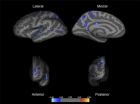(Press-News.org) WORCESTER, MA – A team of scientists led by researchers at the University of Massachusetts Medical School (UMMS) and the University of Miami Miller School of Medicine (UMMSM) have identified what is likely a key genetic pathway underlying bipolar (manic depressive) disorder, a breakthrough that could lead to better drugs for treating bipolar affective disorder, as well as depression and other related mood disorders.
The new findings, published online this week in Nature Molecular Psychiatry, show that a rare genetic dwarfism called Ellis van-Creveld (EvC) syndrome protects against bipolar affective disorder. The discovery was made thanks to decades of translational research in a few Old Order Amish families of Pennsylvania with a high incidence of both diseases. Forty years of documented research across multiple generations showed that no person with EvC has been reported with bipolar disorder.
"No one doubts that bipolar affective disorder has an important, disease causing genetic component," said neurologist and geneticist Edward I. Ginns, MD, PhD, professor of psychiatry at UMMS and lead author of the study. "In our search for the causes of bipolar affective disorder, this is a paradigm changing discovery that could lead to better treatments."
Bipolar affective disorder is a common psychiatric illness characterized by recurring swings from periods of high energy and mania to periods of low energy and sadness. During periods of mania the need for sleep is reduced and a person feels or acts abnormally happy, energetic and impulsive. They often make poorly thought out decisions with little regard for the consequences. Cycles of depression may include crying, poor eye contact with others, and a negative outlook on life. Patients suffering from bipolar disorder have a higher risk for suicide and self-harm and suffer from other ailments, such as heart disease, related to poor lifestyle choices.
Though many factors likely contribute to onset of the disease, various studies over the years have provided ample evidence that there is an important genetic component to the illness. However, previous attempts to isolate individual genes connected to bipolar disorder have been unsuccessful.
In her research among the Old Order Amish, which extends back more than 40 years, Janice A. Egeland, PhD, professor emerita of psychiatry and behavioral sciences at UMMSM and co-author of the current study, found that both EvC and bipolar were prevalent in an extended family descended from the same progenitor. Both conditions clearly travelled together over the generations in a few families extending from this same pioneer. Yet no person with EvC was ever reported with bipolar disorder despite decades of research across multiple generations.
"Few research efforts can claim to have extended over half a century using various building stones to reach a goal," said Dr. Egeland.
EvC dwarfism results from genetic mutations that disrupt the signaling pathway known as sonic hedgehog (Shh). Statistical analyses confirmed the significant negative association between EvC and bipolar disorder. This further suggested that the Shh pathway plays a role in bipolar disorder.
"Since mutations causing EvC do so by disrupting Shh protein function, linking abnormal Shh signaling to major affective disorders provides a concrete molecular and medical basis for patients' symptoms that should help break down the stigma associated with mental illnesses," said Ginns. "If we can understand more details of the Shh signaling pathway in bipolar disorder, it could dramatically change the way we diagnose and treat these conditions."
According to Ginns, drugs already in clinical trials for other medical conditions that target Shh protein signaling may have the potential to be better treatments for bipolar disorder. "Importantly, it's possible that drugs that modulate Shh signaling may offer a new strategy for treating some patients with affective disorders," he said.
The current findings are supported by an earlier genome-wide search for genetic loci linked to mental health wellness in relatives at high risk for bipolar disorder among the Old Order Amish, published by Dr. Ginns and colleagues in PNAS (1998). "Revisiting our work from the late 90s has paid off. There's a joy of following up linkage work as new information becomes available," said Robert C. Elston, professor of epidemiology and biostatistics at Case Western Reserve University.
"I wish for the patient's sake that we could have put this puzzle together a decade ago, but some of the pieces were not known until more recently," said Marzena Galdzicka, PhD, clinical assistant professor of pathology at UMMS.
Ginns cautioned that although "we have a good idea of potential novel drug target(s) that could stop symptoms, it's still unclear what changes along the Shh pathway lead to bipolar disorder. The Shh pathway involves more than a dozen other molecules, and interacts with over 100 other genes. It's likely that other genes or proteins in this pathway may participate in determining the various symptoms and sometimes catastrophic outcomes seen in patients with affective disorders, including suicide."
Ginns and his collaborators are already working to unravel more details of the puzzle and identify changes in the Shh signaling and related pathways that correlate with disease symptoms. "Even though the symptoms of bipolar affective disorder can be quite varied and complicated, the underlying genetics might actually have a more simple cause than we could have imagined," said Ginns.
INFORMATION:
About the University of Massachusetts Medical School
The University of Massachusetts Medical School (UMMS), one of five campuses of the University system, comprises the School of Medicine, the Graduate School of Biomedical Sciences, the Graduate School of Nursing, a thriving research enterprise and an innovative public service initiative, Commonwealth Medicine. Its mission is to advance the health of the people of the commonwealth through pioneering education, research, public service and health care delivery with its clinical partner, UMass Memorial Health Care. In doing so, it has built a reputation as a world-class research institution and as a leader in primary care education. The Medical School attracts more than $240 million annually in research funding, placing it among the top 50 medical schools in the nation. In 2006, UMMS's Craig C. Mello, PhD, Howard Hughes Medical Institute Investigator and the Blais University Chair in Molecular Medicine, was awarded the Nobel Prize in Physiology or Medicine, along with colleague Andrew Z. Fire, PhD, of Stanford University, for their discoveries related to RNA interference (RNAi). The 2013 opening of the Albert Sherman Center ushered in a new era of biomedical research and education on campus. Designed to maximize collaboration across fields, the Sherman Center is home to scientists pursuing novel research in emerging scientific fields with the goal of translating new discoveries into innovative therapies for human diseases.
Rare genetic disease protects against bipolar disorder
UMMS and UMMSM researchers uncover genetic pathway that could lead to better treatments
2014-10-14
ELSE PRESS RELEASES FROM THIS DATE:
Millennials uneducated on important clothing care skills, MU study finds
2014-10-14
COLUMBIA, Mo. – As more and more high schools around the country drop home economics classes due to budget cuts or changes in educational priorities, many high school students are left without basic skills, such as preparing meals and sewing. Now, researchers have found that a significant gap exists in the amount of "common" clothes repair skills possessed by members of the baby boomer generation and millennials. Pamela Norum, a professor in the Department of Textile and Apparel Management in the MU College of Human Environmental Sciences, found that many more of ...
MAVEN's first look at Mars holds surprises, says CU-Boulder mission leader
2014-10-14
NASA's MAVEN spacecraft has provided scientists their first look at a storm of energetic solar particles at Mars and produced unprecedented ultraviolet images of the tenuous oxygen, hydrogen and carbon coronas surrounding the Red Planet, said University of Colorado Boulder Professor Bruce Jakosky, the mission's principal investigator.
In addition, the new observations allowed scientists to make a comprehensive map of highly variable ozone in the Martian atmosphere underlying the coronas, he said. The spacecraft entered Mars' orbit Sept. 21 and is in the process of lowering ...
Autophagy helps fast track stem cell activation
2014-10-14
HEIDELBERG, 14 October 2014 – Researchers from Stanford University School of Medicine have discovered a link between a protective mechanism used by cells and the activation of muscle stem cells. Cells use autophagy to recycle cellular "building blocks" and generate energy during times of nutrient deprivation. The scientists report in The EMBO Journal that when this protective mechanism is operational it also seems to assist in the activation of stem cells.
"Our study reveals that when stem cells emerge from a quiescent state there is a rapid and dramatic change in ...
Testing parents' patience, while treating kids' problem behavior
2014-10-14
Humans have a focus on the short term. We are more interested in a potential benefit if we can get it now.
The ability to delay gratification has been studied in children with the "marshmallow test": a child can have one treat now, or two if he or she can wait a few minutes without gobbling the first treat.
Psychologists and economists have shown that similar trends can be observed and measured in many spheres of life. They call the tendency for the perceived value of a delayed benefit to diminish "delay discounting."
Now researchers at Marcus Autism Center are studying ...
NASA satellite spots Hudhud's remnants
2014-10-14
Cyclone Hudhud made landfall in east-central India on Oct. 12 and caused a lot of damage and several fatalities as it moved inland and weakened to a remnant low pressure area. NASA saw those remnants on Oct. 14.
When NASA's Aqua satellite passed over Indochina, the Moderate Resolution Imaging Spectroradiometer or MODIS instrument provided picture proof that the remnants of Typhoon Hudhud were still over India, Nepal, and China. Aqua passed over the region on Oct. 14 at 08:05 UTC (4:05 a.m. EDT).
Infrared satellite imagery and multispectral satellite imagery indicated ...
EMA open to discuss use of complementary methodologies for rare cancers
2014-10-14
On 3 October 2014, the European Medicines Agency (EMA) hosted a meeting with representatives of Rare Cancers Europe (RCE) to discuss RCE's recent publication of a consensus paper on the methodology of clinical trials in rare cancers (1).
Rare Cancers Europe (RCE) is a multi stakeholder initiative promoted by ESMO (representing healthcare professionals, patients and industry) dedicated to putting rare cancers on the European political agenda. In their consensus document, RCE argue that a higher degree of uncertainty should be accepted for regulatory as well as clinically ...
New information about how neurons act could lead to brain disorder advancements
2014-10-14
COLUMBIA, Mo. – Neurons are electrically charged cells, located in the nervous system, that interpret and transmit information using electrical and chemical signals. Now, researchers at the University of Missouri have determined that individual neurons can react differently to electrical signals at the molecular level and in different ways—even among neurons of the same type. This variability may be important in discovering underlying problems associated with brain disorders and neural diseases such as epilepsy.
"Genetic mutations found in neurological disorders ...
Orphanage care linked to thinner brain tissue in regions related to ADHD
2014-10-14
Under the rule of dictator Nicolae Ceausescu, thousands of Romanian children were placed in overcrowded orphanages with bleak conditions and minimal human contact. Even after the 1989 revolution, the legacy of institutionalization continued. Only recently has research and public concern over early childhood environments caused changes in policies.
University of Washington research on children who began life in these institutions shows that early childhood neglect is associated with changes in brain structure. A paper published this month in Biological Psychiatry shows ...
Corruption of the health care delivery system
2014-10-14
LEBANON, NH – The foundation of evidence-based research has eroded and the trend must be reversed so patients and clinicians can make wise shared decisions about their health, say Dartmouth researchers in the journal Circulation: Cardiovascular Quality and Outcomes.
Drs. Glyn Elwyn and Elliott Fisher of The Dartmouth Institute for Health Policy & Clinical Practice are authors of the report in which they highlight five major problems set against a backdrop of "obvious corruption." There is a dearth of transparent research and a low quality of evidence synthesis. ...
Personalised treatment for stress-related diabetes
2014-10-14
Researchers at Lund University in Sweden are testing a treatment for type 2 diabetes which targets the disease mechanism itself - and not just the symptoms. For the first time, knowledge about the individual patient's genetic risk profile is being used. The treatment completely restores the capacity to secrete insulin, which is impaired by the risk gene.
"The concept of treatment personalised to the individual's risk profile has great potential. Our results show that it is possible to block the effects of a common risk gene for type 2 diabetes", says Anders Rosengren, ...
LAST 30 PRESS RELEASES:
Exploring how the visual system recovers following injury
Support for parents with infants at pediatric check-ups leads to better reading and math skills in elementary school
Kids’ behavioral health is a growing share of family health costs
Day & night: Cancer disrupts the brain’s natural rhythm
COVID-19 vaccination significantly reduces risk to pregnant women and baby
The role of vaccination in maternal and perinatal outcomes associated with COVID-19 in pregnancy
Mayo Clinic smartwatch system helps parents shorten and defuse children's severe tantrums early
Behavioral health spending spikes to 40% of all children’s health expenditures, nearly doubling in a decade
Digital cognitive behavioral treatment for generalized anxiety disorder
Expenditures for pediatric behavioral health care over time and estimated family financial burden
Air conditioning in nursing homes and mortality during extreme heat
The Alps to lose a record number of glaciers in the next decade
What makes a good proton conductor?
New science reporting guide published for journalists in Bulgaria
New international study reveals major survival gaps among children with cancer
New science reporting guide published for journalists in Turkey
Scientists develop a smarter mRNA therapy that knows which cells to target
Neuroanatomy-informed brain–machine hybrid intelligence for robust acoustic target detection
Eight SwRI hydrogen projects funded by ENERGYWERX
The Lundquist Institute and its start-up company Vitalex Biosciences Announces Strategic Advancement of Second-Generation fungal Vaccine VXV-01 through Phase 1 Trials under $40 Million Competitive Con
Fine particles in pollution are associated with early signs of autoimmune disease
Review article | Towards a Global Ground-Based Earth Observatory (GGBEO): Leveraging existing systems and networks
Penn and UMich create world’s smallest programmable, autonomous robots
Cleveland researchers launch first major study to address ‘hidden performance killer’ in athletes
To connect across politics, try saying what you oppose
Modulating key interaction prevents virus from entering cells
Project explores barriers to NHS career progression facing international medical graduates
Jeonbuk National University researchers explore the impact of different seasonings on the flavor perception of Doenjang soup
Two Keck Medicine of USC Hospitals named Leapfrog Top Teaching Hospitals
World-first discovery uncovers how glioblastoma tumours dodge chemotherapy, potentially opening the door to new treatments
[Press-News.org] Rare genetic disease protects against bipolar disorderUMMS and UMMSM researchers uncover genetic pathway that could lead to better treatments




